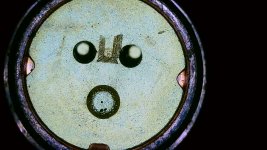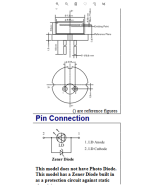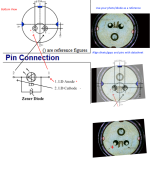Hello men,
i just "found" these markings on my new Nichia NUBMOE 5,5w Laser diode..i never realized they were there until now. Do this lines, maybe, give information whats the anode and what is Cathode? I must say i still have troubles getting sure what the polarity is. The usual datasheets confuse me, because i cant make out which pin is 1 and 2, because i dont know with confidence from which side that picture shows the diode. Im still dependet on "idiotproof" pictures with the pins.
i will link a picture from a datasheet of the NBD7275,(didnt find any of my NUBMOE yet...), hoping i can clarify my difficulty and that someone can tell me if im right or wrong...
so in the middle picture, its said that the right pin is 2 and left pin is 1. The diode is placed in a way that the pins are at bottom, or, with other words, the side without "a small piece missing at the edge" is downwards. Now does that mean, if the diode is in front of me like that, the right pin is cathode(neg)??
Because in the bottom picture it is said, pin 2 is cathode. But in the bottom picture 2 is left and 1 is right. Now the picture does not look like the physical form of a diode but its still confusing me.
i just "found" these markings on my new Nichia NUBMOE 5,5w Laser diode..i never realized they were there until now. Do this lines, maybe, give information whats the anode and what is Cathode? I must say i still have troubles getting sure what the polarity is. The usual datasheets confuse me, because i cant make out which pin is 1 and 2, because i dont know with confidence from which side that picture shows the diode. Im still dependet on "idiotproof" pictures with the pins.
i will link a picture from a datasheet of the NBD7275,(didnt find any of my NUBMOE yet...), hoping i can clarify my difficulty and that someone can tell me if im right or wrong...
so in the middle picture, its said that the right pin is 2 and left pin is 1. The diode is placed in a way that the pins are at bottom, or, with other words, the side without "a small piece missing at the edge" is downwards. Now does that mean, if the diode is in front of me like that, the right pin is cathode(neg)??
Because in the bottom picture it is said, pin 2 is cathode. But in the bottom picture 2 is left and 1 is right. Now the picture does not look like the physical form of a diode but its still confusing me.








![DSCI1783[1].JPG](/data/attachments/57/57490-70187bea7f3838e5d4bcf99fb0cbf443.jpg?hash=cBh76n84OO)
